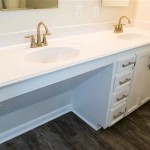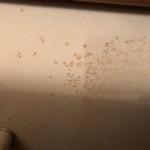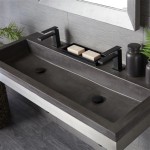What Paint Should You Use for Bathroom Vanity Units?
Bathroom vanities endure significant wear and tear due to constant exposure to moisture, temperature fluctuations, and cleaning products. Choosing the right paint is crucial for ensuring a durable and attractive finish that can withstand these challenging conditions. This article explores the best paint options for bathroom vanity units, considering factors like durability, moisture resistance, and ease of application.
Key Considerations for Bathroom Vanity Paint
Several factors influence the suitability of a paint type for bathroom vanities. Understanding these considerations helps narrow down the best choice for your specific needs.
*
Moisture Resistance:
The paint must withstand high humidity and occasional splashes of water without peeling or bubbling. *Durability:
Bathroom vanities are frequently used, requiring a paint finish that resists scuffs, scratches, and chipping. *Ease of Cleaning:
The paint should be easy to wipe clean with common bathroom cleaners without degrading the finish. *Finish:
The sheen of the paint affects its appearance and durability. Higher sheen levels offer better moisture resistance but may highlight imperfections. *VOC Content:
Volatile organic compounds (VOCs) are released as the paint dries and can contribute to indoor air pollution. Opting for low-VOC or zero-VOC paints is environmentally responsible and healthier.Recommended Paint Types for Bathroom Vanities
Based on the above considerations, several paint types stand out as excellent choices for bathroom vanity units.
1. Oil-Based Enamel
Oil-based enamel paints provide a hard, durable finish with excellent moisture resistance. They create a smooth, washable surface that's ideal for high-traffic areas like bathrooms. However, they have a strong odor during application and require mineral spirits for cleanup. Proper ventilation is crucial when using oil-based paints.
2. Latex Enamel
Latex enamel paints offer a good balance of durability, moisture resistance, and ease of application. They dry quickly, have lower VOCs than oil-based paints, and clean up easily with water. While not quite as durable as oil-based enamel, latex enamel provides a satisfactory finish for most bathroom vanity applications.
3. Acrylic Latex Enamel
Acrylic latex enamel paints are a subset of latex paints formulated with acrylic resins for enhanced durability and adhesion. They provide excellent moisture resistance and are a good choice for bathroom vanities in humid climates. Like other latex paints, they are low in VOCs and easy to clean up.
4. Chalk-Style Paint
Chalk-style paint has gained popularity for its matte finish and versatility. While not inherently moisture-resistant, it can be used effectively on bathroom vanities when sealed properly with a high-quality sealant. The sealant provides the necessary protection against moisture and allows for easy cleaning.
5. Milk Paint
Milk paint is a natural, non-toxic option for painting bathroom vanities. Similar to chalk paint, it requires a sealant for moisture protection. Milk paint offers a unique, slightly textured finish that can add character to a bathroom vanity. However, the sealant application is crucial for its long-term performance in a humid environment.
Primer and Surface Preparation
Regardless of the chosen paint type, proper surface preparation is essential for achieving a durable and professional-looking finish.
*
Cleaning:
Thoroughly clean the vanity surface with a degreaser to remove any dirt, grime, or soap residue. *Sanding:
Lightly sand the surface to create a slightly rough texture for better paint adhesion. *Priming:
Applying a primer specifically designed for the chosen paint type helps ensure proper adhesion and improves the overall finish. A moisture-resistant primer is recommended for bathroom vanities.Application Techniques
Proper application techniques contribute to a smooth, even finish. Consider the following tips:
*
Brush Selection:
Use high-quality brushes appropriate for the chosen paint type. *Thin Coats:
Apply thin, even coats of paint, allowing each coat to dry completely before applying the next. *Ventilation:
Ensure adequate ventilation during the painting process, especially when using oil-based paints.Choosing the Right Sheen
The paint's sheen, or gloss level, affects both its appearance and its durability.
*
High-Gloss:
Offers maximum durability and moisture resistance but can highlight imperfections. *Semi-Gloss:
Provides good durability and moisture resistance with a less reflective finish. *Satin:
Offers a softer sheen with moderate durability and moisture resistance. *Matte:
Provides a non-reflective finish but offers less moisture resistance and is more susceptible to showing marks.Maintaining Your Painted Vanity
Proper maintenance helps extend the life of your painted vanity. Regularly cleaning the vanity with a mild cleaner and avoiding abrasive cleaning products helps preserve the finish. Addressing any chips or scratches promptly prevents moisture from penetrating the paint and causing further damage.

How To Paint Bathroom Cabinets Without Sanding 8 Vital Steps Grace In My Space
:max_bytes(150000):strip_icc()/grey-08207753dd3b407caadbbb47253586a3.jpg?strip=all)
30 Bathroom Cabinet Color Ideas From Basic To Bold

How To Paint Bathroom Vanity Cabinets Tutorial Benjamin Moore

How To Paint Laminate Cabinets Love Renovations

How To Paint Cabinets Last Painting A Bathroom Vanity Maison De Pax

How To Paint Bathroom Vanity Cabinets Tutorial Benjamin Moore

Painting A Bathroom Vanity Again Dream Green Diy

How To Paint Bathroom Cabinets Diyer S Guide Bob Vila

Bathroom Vanity Makeover With Chalk Paint Decor Adventures

Beautiful Paint Color Ideas For Bathroom Vanity Cabinet Guilin Cabinets
Related Posts







